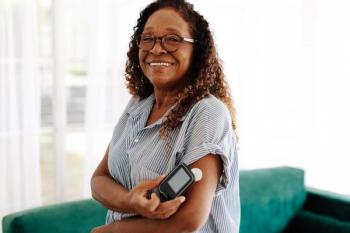
Instrument helps quantify tear film osmolarity, may guide dry eye therapy
Accurately quantifying tear film osmolarity and subjectively analyzing the course of dry eye therapy are two goals of research being conducted.
Waterloo, Ontario, Canada-Accurately quantifying tear film osmolarity and subjectively analyzing the course of dry eye therapy are two goals of research being conducted by Adam Keech, OD, a research optometrist at the University Of Waterloo, Ontario, Canada.
The research is scheduled to be presented at the annual meeting of the Association for Research and Vision in Ophthalmology, May 2-6 in Ft. Lauderdale, FL.
Dr. Keech and his colleagues used a diagnostic micro-osmometer (TearLab Osmolarity System, OccuLogix Inc., DBA TearLab Corp.) to analyze tear film obtained from the inferior lateral meniscus of 10 patients with dry eye disease (Ocular Surface Disease Index Score [OSDI] of > 20) and 10 controls.
Tears were collected eight times per day from each patient-four samples from each patient at 15-minute intervals, and then at 1-minute intervals. Tear collections were performed on all patients on three separate days, for a total of 960 tear samples.
Patients in the dry eye group had symptom scores and maximum per-subject osmolarity scores that were significantly higher than subjects in the control group. Among the dry eye patients, who had OSDI scores of 40.0 ±14.8, osmolarity was 321.0 ±10.7 for tear samples collected at 1 minute intervals, and 315.9 ± 9.5 for samples collected at 15 minute intervals (p < 0.005).
Among the controls, who had OSDI scores of 7.1 ± 4.4, the osmolarity was 300.9 ± 6.1 and 297.8 ± 5.9, respectively, among the samples collected at 1 minute intervals and those collected at 15 minute intervals (p < 0.005).
Improving diagnostic capabilities
Dr. Keech noted that the dry eye patients in this study had a significantly higher standard degree of osmolarity in each eye compared with the controls. None of the patients from either group, however, showed any significant difference in osmolarity between samples collected at 15-minute intervals and those collected at 1-minute intervals.
"It's commonly thought that reflex tearing, such as that caused by the glass pipette used for tear collection, artificially changes the osmolarity of the tear film compared to the patient's basal tear film," Dr. Keech told Optometry Times. "We did not find that to be the case."
Dr. Keech noted that while studies have consistently shown that people with high tear osmolarity are more likely to have dry eye, the difficulty has always been quantifying exactly how many particles were seen in the tear film.
"One of the difficulties in diagnosing dry eye is that there are so few quantitative techniques that are available to us, and most often we just rely on a patient's symptoms," Dr. Keech said.
"So we're always looking for that diagnostic technique that can give us a quantitative answer to tell us how dry the eye actually is instead of relying on a qualitative assessment by the patient," he added.
Some instruments are currently available to measure osmolarity, but they've traditionally been lab-based only, according to Dr. Keech. "They're either too large or they require a technician to run them so it hasn't been feasible to implement them in the clinical setting," he said.
Instrument shows promise
The hand-held micro-osmometer used in this study shows promise to change that, and to open the door for easy in-office osmolarity analysis.
"The trick has always been finding an instrument that can quantify osmolarity and also is efficient enough to use in clinical practice," Dr. Keech said. "It's not so much that we can say, 'Yes, this person has dry eyes,' but also to use it to chart improvements in patients' symptoms.
"So if a patient comes in on day 1 and we establish an osmolarity of X, then we can monitor the effectiveness of our chosen treatment when the patient returns 2 or 3 weeks later. Charting treatment success or failure is where we see the real value of our research and the hand-held micro-osmometer instrument."
FYI
Adam Keech, OD
Phone: 519/888-4567
E-mail:
Dr. Keech receives research funding from Alcon Laboratories.
Newsletter
Want more insights like this? Subscribe to Optometry Times and get clinical pearls and practice tips delivered straight to your inbox.













































